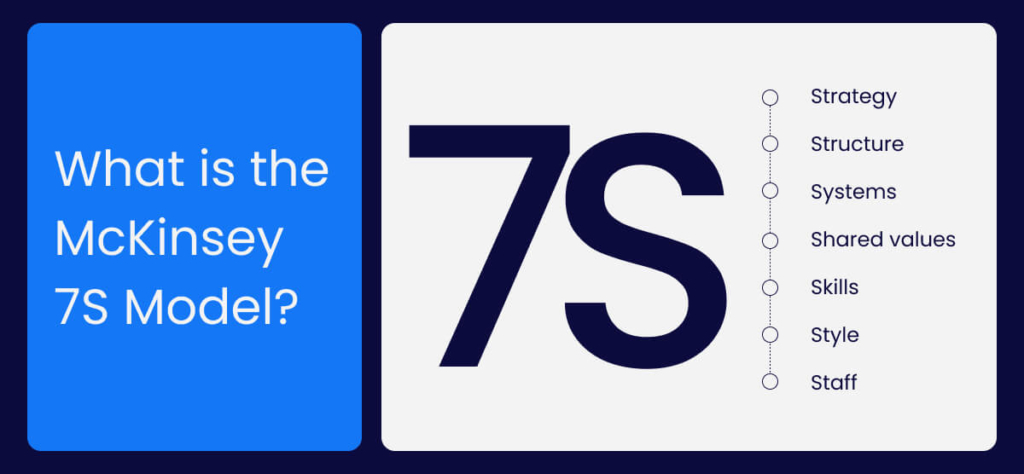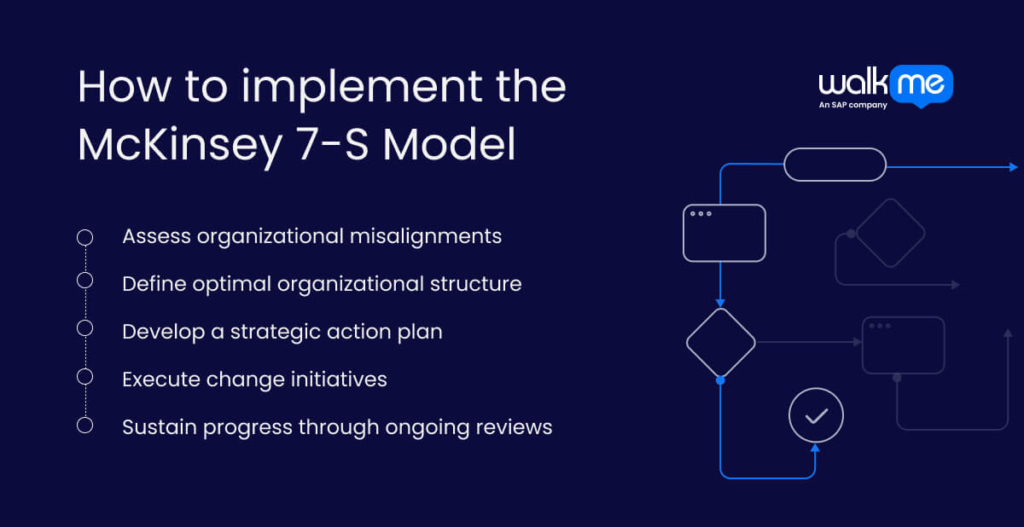Modern enterprises are navigating a wave of turbulence, including digital innovation, shifting customer expectations, and economic uncertainty.
Even the most promising change management strategies can fail if an organization’s internal mechanics aren’t aligned, which is exactly what the McKinsey 7S Model was built to address. The model pushes leaders to look beyond strategy and structure, asking how culture, leadership style, and people’s skills fit together.
In a recent McKinsey survey, 63% of companies said that their operating‐model redesigns met most of their objectives and improved performance. This underlines the logic of the 7S Model, highlighting how refinement happens when strategy and systems are balanced with softer elements such as skills, values, and leadership style.
With that in mind, this article explores the McKinsey 7S Model, showing how organizations can uncover hidden gaps and turn insight into real, lasting results.
What is the McKinsey 7S Model?

The McKinsey 7S Model is a framework that ensures all parts of a company work together.
It identifies seven internal elements, including:
- Strategy
- Structure
- Systems
- Shared values
- Skills
- Style
- Staff
If you tweak one aspect, say, strategy, but ignore the others, the whole thing may collapse. The power of the model lies in its ability to diagnose problems and reveal where misalignment resides.
For example, Allianz Germany’s overhaul of its motor insurance arm is a textbook 7S use case. Their strategy shifted toward customer-centric growth, and the structure was reshaped so sales, claims, and digital teams actually worked as a single unit.
Systems were also modernized with automation technology and omnichannel sales tools. Staff training in digital reskilling, leadership styles that push collaboration, and refreshed values around customer trust also tied it together.
Why is the McKinsey 7S Model important?
The McKinsey 7S Model is important because it exposes the hidden mechanisms that make a company tick. Even the most robust strategies falter if skills fall short, leadership style clashes with the culture, or if shared values are unclear.
The model compels change management leaders to adopt a holistic perspective on the entire organization, encompassing how systems, staff, and intangible elements interrelate. Rather than just flagging problems, the McKinsey 7S Model guides reflective adjustments.
It also helps organizations move with coherence instead of friction. Companies that use it are usually proactive instead of reactive and often orchestrate success from the inside out.
What are the core elements of the McKinsey 7s framework?
The McKinsey 7S framework illustrates how a company operates by distinguishing between the tangible aspects you can control and the intangible ones that shape behavior and culture. It breaks elements into “hard” and “soft” factors that shape how people work.
The table below shows the hard and soft elements of the McKinsey 7S Model and how each shapes an organization:
| Type | Element | Summary |
| Hard Elements | Structure | How reporting lines, teams, and workflows are organized. Keeps strategy, systems, and people aligned. |
| Strategy | The plan that links vision to action and guides priorities and resources. | |
| Systems | Processes and tools that drive daily operations and track performance. | |
| Soft Elements | Shared Values | Core beliefs and culture that unify decisions and behavior. |
| Skills | Capabilities within the workforce that enable execution and innovation. | |
| Style | Leadership approach that shapes tone, trust, and collaboration. | |
| Staff | The people behind the work, their roles, engagement, and development. |
How to implement the McKinsey 7-S Model

Implementing the McKinsey 7S Model means looking under the hood of your organization and tuning both hard and soft elements so they work together.
Think of implementation as a deliberate process to align people, processes, and culture. This will turn strategy from an idea into a smooth, everyday performance.
Let’s take a closer look at how to implement the McKinsey 7-S Model:
Assess organizational misalignments
Start by shining a spotlight on friction points. Map how strategy, systems, and culture interact and watch for gaps that slow performance. Talk to teams, observe workflows, and dig into data. Misalignments often hide in plain sight and can be anything from conflicting priorities, unclear roles, or leadership disconnects. Spotting these early sets the foundation, giving you a clear picture of what works, what doesn’t, and where interventions will have the greatest impact.
Define optimal organizational structure
Reimagine who reports to whom, how teams collaborate, and where decision-making lives. Think of structure as the foundation that supports and drives strategy throughout the company. If there are too many instabilities, the structure risks collapsing. Align roles, responsibilities, and reporting lines to support goals, ensuring information flows and authority is clear. A purposeful structure accelerates action and creates space for talent to thrive while keeping change management agile.
Develop a strategic action plan
Turn insight into a roadmap and prioritize interventions that address misalignments first, then sequence initiatives so the organization can absorb change without overload. Assign owners, set deadlines, and define success metrics. This plan must translate vision into practical steps everyone can follow. The clarity of the plan determines momentum. Remember, vague or scattered efforts leave teams frustrated and change unfinished.
Execute change initiatives
This is where ideas meet reality, and the importance of communicating clearly, engaging stakeholders, and making the invisible visible becomes apparent. Provide resources, remove obstacles, and monitor the adoption process. Expect resistance, after all, it’s a sign people care. Then, use it to adjust, coach, and reinforce. Think of execution as less about rigidly following the plan and more about orchestrating people, processes, and culture so that every move nudges the organization toward organizational alignment.
Sustain progress through ongoing reviews
Alignment isn’t a one-time event, so make a habit of scheduling regular check-ins, tracking metrics, and reviewing how softer elements interact. Celebrate successes, course-correct when gaps emerge, and maintain change management communication. This helps create more business resilience, making it easier to adapt as markets, technology, and talent evolve. In this regard, the 7S Model should be viewed as a framework that enables the enterprise to move in harmony.
What are the benefits of the McKinsey 7-S Model?
The McKinsey 7S Model reveals how all parts of a company connect, helping leaders fix weak spots, build on strengths, and boost lasting performance.
Let’s take a look at the benefits of the McKinsey 7S Model:
Enables coherent alignment
The 7S Model brings every part of an organization into sync. Teams, processes, and culture move together, making priorities clear and decisions faster. Misalignments become visible, allowing leaders to act before problems grow out of proportion. Alignment transforms scattered efforts into purposeful action, enabling the company to operate as a unified, focused entity.
Tracks change impact
Change affects more than one area at a time. The 7S framework enables leaders to see how adjustments ripple throughout the organization. It also highlights what works, what doesn’t, and how behavior shifts. Tracking impact ensures change is deliberate, not accidental, helping organizations learn quickly and adjust before mistakes become costly.
Proven organizational framework
The 7S Model endures because it delivers results. It uncovers hidden friction, showing where efforts stall and where potential thrives. Leaders gain a practical method to coordinate action, make smarter decisions, and build momentum. The framework enables organizations to achieve lasting, meaningful improvements rather than temporary fixes.
What are the challenges of the McKinsey 7-S Model?
The McKinsey 7S Model is powerful, but it’s not without hurdles. Understanding and aligning all seven components can be complex, and applying the framework effectively requires both careful observation and sound judgment.
Let’s take a closer look at the challenges of the McKinsey 7-S Model:
Long-term framework
The 7S Model works best when applied consistently over time, but this can be daunting. Organizations facing urgent pressures may struggle to maintain focus, and short-term crises often pull attention away. A long-term commitment is essential, as insights fade and alignment efforts fail to take root and produce a measurable impact.
Static nature in a dynamic environment
Markets, technology, and customer expectations evolve rapidly, but the 7S Model can feel rigid. Its structure assumes stability, making it harder to capture sudden shifts. Leaders must carefully adapt their principles; otherwise, the framework risks lagging behind real-world changes, leaving organizations internally aligned but disconnected from external realities.
Focuses on internal factors
The 7S Model excels in internal alignment, yet it largely overlooks external pressures, such as competition, regulation, and market disruption. Companies can optimize themselves perfectly and still underperform if they ignore outside forces. Leaders must complement the framework with external analysis to ensure internal adjustments deliver meaningful results in context.
Real-world example of the McKinsey 7-S Model
The McKinsey 7S Model provides a lens for understanding how enterprises align their strategy, culture, and operations to drive sustained innovation.
The table below breaks down each element, showing how Apple uses the 7S model to maintain its competitive edge and deliver exceptional products:
| Element | Overview |
| Strategy | Apple sets itself apart with sleek design, useful features, and a connected product ecosystem. It keeps prices high to signal quality while growing services and new tech to reduce reliance on iPhones. |
| Structure | Senior leaders drive decisions, but cross-team projects bring people together. This mix of oversight and teamwork helps ideas move smoothly from concept to launch. |
| Systems | Hiring, reviews, and product design follow clear processes. Products are tested and improved at every stage, ensuring high quality and keeping teams aligned. |
| Style | Leaders set direction but allow teams freedom to try new ideas. This balance builds trust, sparks creativity, and keeps innovation flowing. |
| Staff | Apple hires carefully and invests in growth. People are motivated by exciting projects and a culture that values creativity and attention to detail. |
| Skills | Teams excel in design, engineering, and software, with a focus on innovation and fast problem-solving. Training and collaboration keep skills sharp and relevant. |
| Shared values | Core values center on innovation, quality, user experience, and secrecy. These guide decision-making and ensure everyone works toward the same goals. |
Driving digital transformation with McKinsey’s 7-S model
Over the years, the 7S Model has become a go-to framework for change management and digital transformation, prized for its tested methodology that countless organizations have used to strengthen performance and alignment.
Its real might comes from turning uncertainty into clarity, so teams move confidently together, decisions land smoothly, and change becomes part of the organization’s natural rhythm.
Looking ahead, it’s crucial to stay proactive, embrace innovations, and adapt the model to your organization’s needs. The 7S Model can guide the journey, but success depends on applying it in a way that supports your people and goals.
Only when all elements are aligned can the framework be fully integrated, and the learning curve mastered through continuous employee training and action.
FAQs
Enterprises have lots of moving parts, which makes change tricky. The 7S Model helps leaders see where things don’t fit and what needs attention first. It provides a clear roadmap, enabling teams to understand their role, work together, and drive change more smoothly across the entire organization.
Global businesses operate in many different places, each with its own challenges. The 7S Model is most effective when leaders understand each location, involve local teams, and adjust plans to suit the local context. Regular check-ins, open communication, and clear responsibilities make sure everyone stays aligned without losing sight of the company’s goals.
Teams spread across the world can easily drift apart. The 7S Model highlights instances where priorities and ways of working don’t align. Leaders can create shared goals, share knowledge, and keep everyone on the same page, while still letting local teams make small adjustments. This helps the entire organization move forward in a unified manner.

